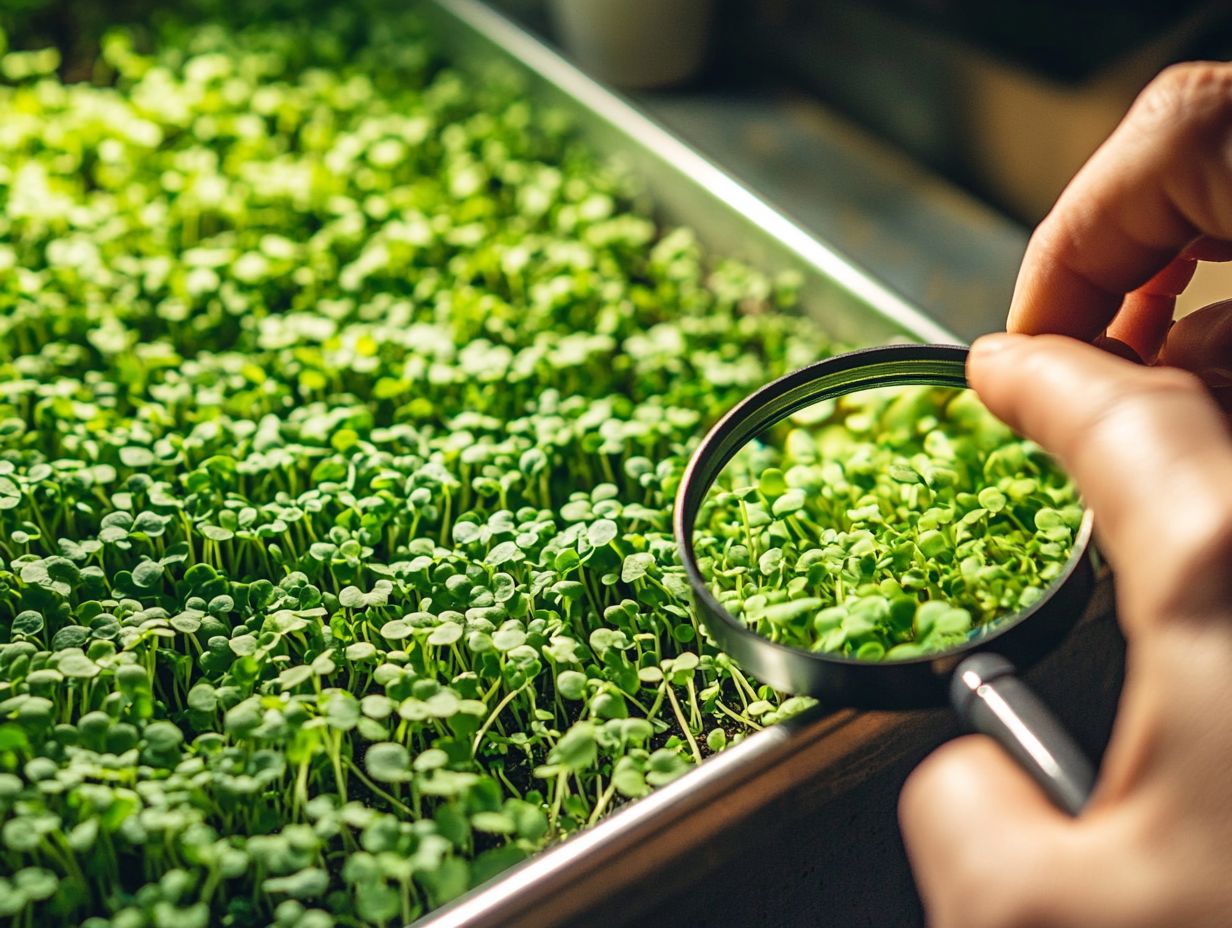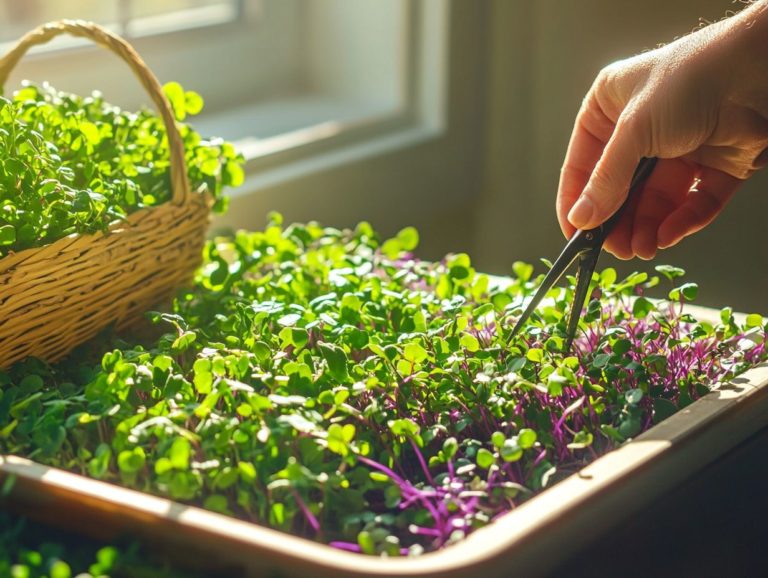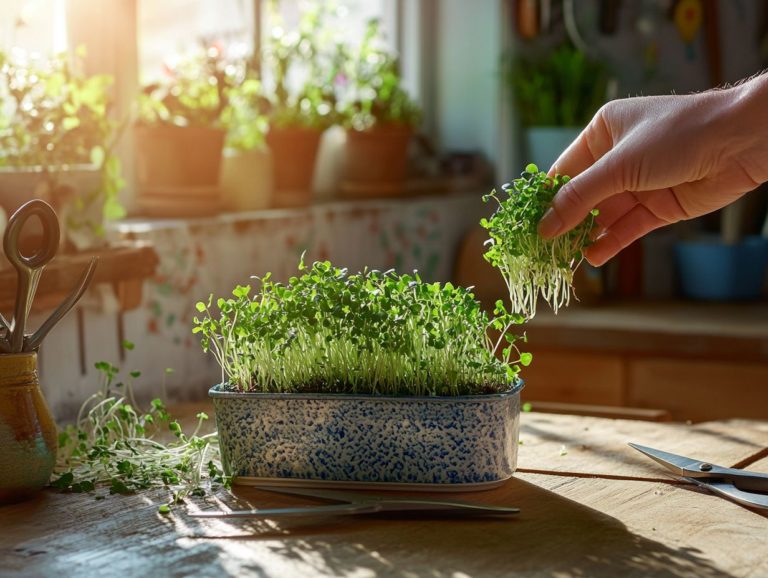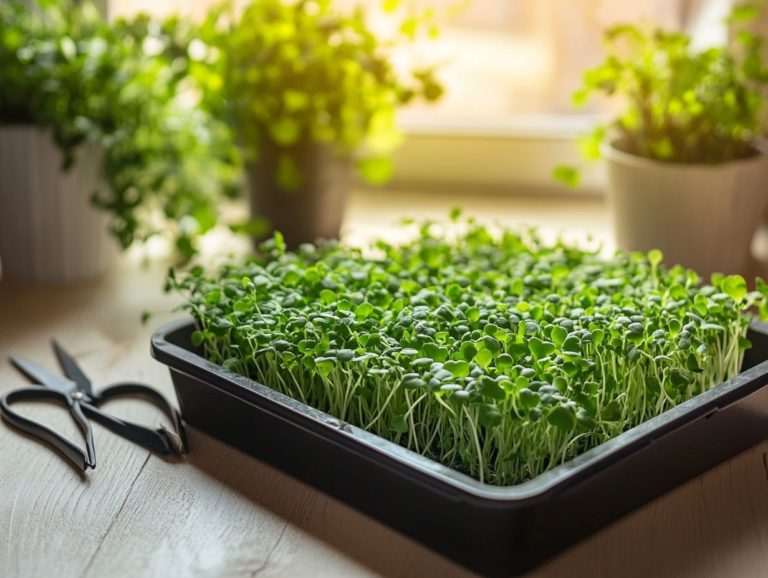The Best Practices for Microgreen Quality Control
Microgreens are transforming the culinary world with their vibrant colors and incredible flavors! They are not only admired for their beauty but also for their remarkable nutritional benefits, including a wealth of antioxidants and plant chemicals that offer health benefits.
Ensuring the quality of these delicate greens is essential for both flavor and safety. This article explores the critical role of quality control in microgreens. It sheds light on potential health risks and their effects on taste and nutrition, focusing on food safety and the importance of disease management.
You ll discover best practices for growing, harvesting, and storing microgreens. Plus, you ll find invaluable tips for maintaining the highest standards in sustainable and sanitation practices. Whether you re cultivating them or simply enjoying them on your plate, understanding these key aspects will empower you to fully embrace the myriad benefits that microgreens have to offer.
Contents
- Key Takeaways:
- Why Quality Control is Important for Microgreens
- Best Practices for Microgreen Quality Control
- Common Quality Issues with Microgreens
- Tips for Maintaining High Quality Microgreens
- Frequently Asked Questions
- What are the best practices for microgreen quality control?
- How often should microgreens be visually inspected for quality control?
- What are some common contaminants to test for in microgreens?
- What factors can affect the quality of microgreens?
- What sanitation practices should be implemented for microgreen quality control?
- How can I ensure the best possible quality for my microgreens?
Key Takeaways:
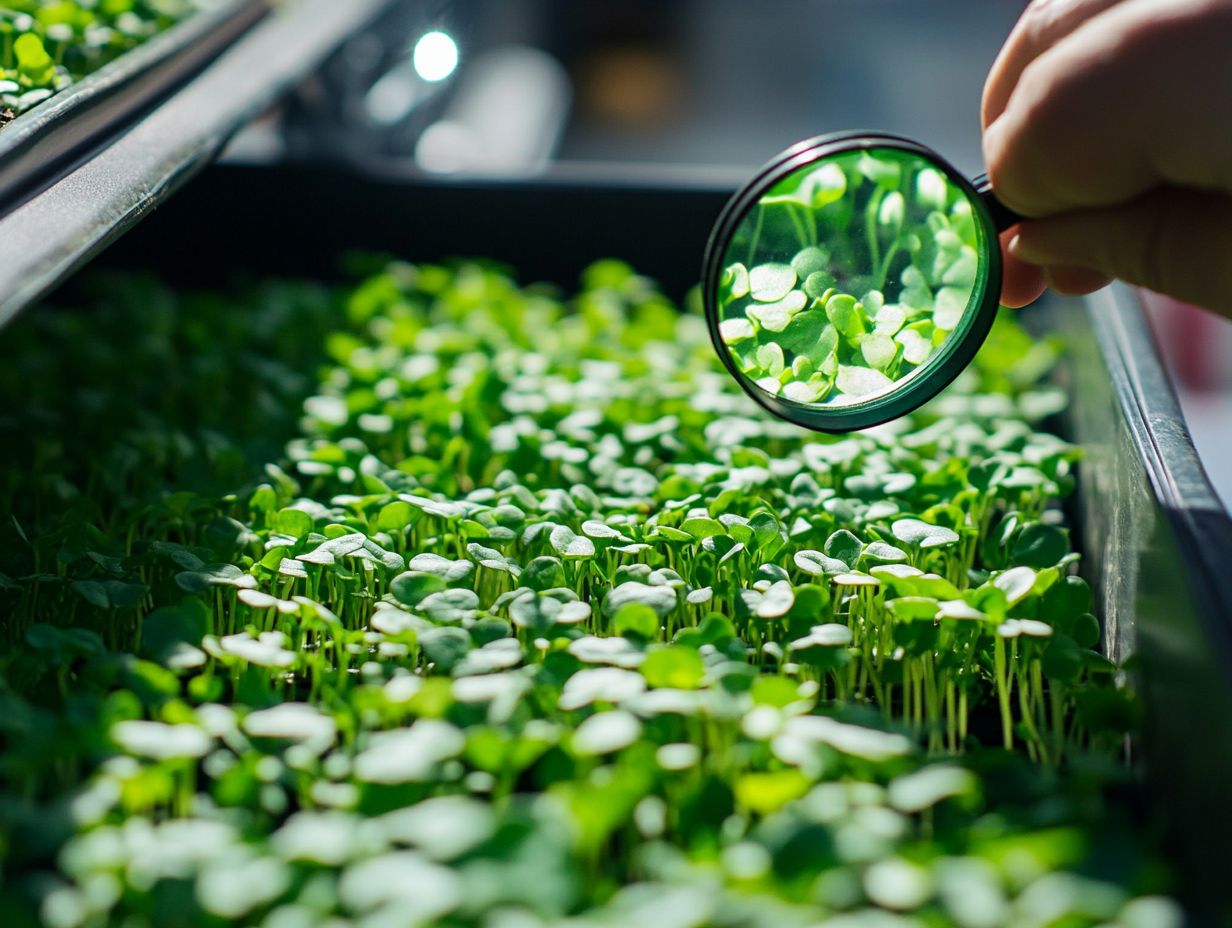
- Regular quality control is crucial for microgreens to ensure they are safe to consume while maintaining optimal flavor and nutrition, promoting customer satisfaction, and environmental sustainability.
- Implementing best practices such as proper growing techniques, using high-quality seeds, following storage guidelines, and conducting regular quality checks can help maintain high-quality microgreens.
- Maintaining proper sanitation, hygiene, and record-keeping is essential for preventing and addressing common quality issues with microgreens, ensuring healthy crops and optimal nutrient supply.
What are Microgreens?
Microgreens are young, edible plants harvested at the seedling stage, boasting vibrant colors, intense flavors, and exceptional nutrient content. They include a wealth of vitamins, minerals, and plant chemicals. Picture varieties like arugula, radish, and basil these tiny greens are powerhouses of health benefits, providing essential antioxidants that support your overall well-being while adding elegance to dishes in high-end restaurants and urban farming initiatives.
Beyond their visual appeal and remarkable taste, microgreens can be cultivated through various methods. These include hydroponics and soil-based systems, making them accessible for both novice gardeners and commercial producers. Nutritionally, these little wonders deliver concentrated doses of vitamins C, E, and K, along with beneficial compounds that may help reduce inflammation and boost your immune system.
Their versatility shines as you incorporate them into salads, smoothies, or as garnishes. They are not just a healthful addition but also elevate culinary experiences across diverse cuisines.
Why Quality Control is Important for Microgreens
Quality control is essential in the production of microgreens. It guarantees food safety and adherence to international standards, ultimately enhancing customer satisfaction and loyalty.
By adopting rigorous quality management systems throughout the cultivation process, you can effectively monitor critical factors such as crop health, production conditions, and sanitation practices. This proactive approach allows you to mitigate risks related to contamination and nutrient deficiency while promoting sustainable practices that reduce environmental impact. Additionally, learning the best ways to grow and store microgreens can enhance your cultivation efforts.
Potential Health Risks
While you may enjoy the health benefits of microgreens, it s essential to be aware of potential health risks that come with improper handling, inadequate sanitation practices, and pest infestations. These risks could lead to harmful pathogens or nutrient imbalances. It is vital for you as a producer to employ strict disease management and sanitation protocols throughout the growing process.
Cultivating microgreens can unintentionally introduce biological contaminants, including notorious bacteria like E. coli and Salmonella. This is especially true if you don’t monitor water quality and seed sources closely. You must adopt rigorous hygiene measures, such as routinely cleaning growing surfaces and equipment to prevent cross-contamination. Understanding the importance of cleanliness in microgreen harvesting is crucial for ensuring a safe and healthy crop.
Implementing effective pest management strategies, such as utilizing natural predators or environmentally safe pesticides, can significantly reduce the likelihood of infestations. Ensuring safety and quality relies on your proactive approach. Staying vigilant and informed about potential risks is crucial to safeguarding the health of consumers eager to enjoy these nutrient-dense greens.
Impact on Flavor and Nutrition
The flavor and nutritional profile of microgreens are greatly influenced by their growing conditions, light quality, and nutrient composition. This makes them an exceptional choice for enhancing both taste and health benefits in your culinary endeavors. These vibrant greens are packed with bioactive compounds, elevating the flavor of your dishes and enriching your diet with essential vitamins and minerals.
The cultivation method you choose whether in soil or a method of growing plants in water without soil can significantly affect their taste and nutrient density. Variations in light exposure, including the spectrum and intensity, can enhance specific flavors while increasing antioxidant levels. By ensuring a proper nutrient balance, particularly with vital elements like nitrogen and phosphorus, you can maximize their growth potential and health benefits.
Incorporating microgreens into your meals allows you to enrich your diet with concentrated sources of nutrition. You can support your overall well-being while savoring a delightful burst of flavor!
Best Practices for Microgreen Quality Control
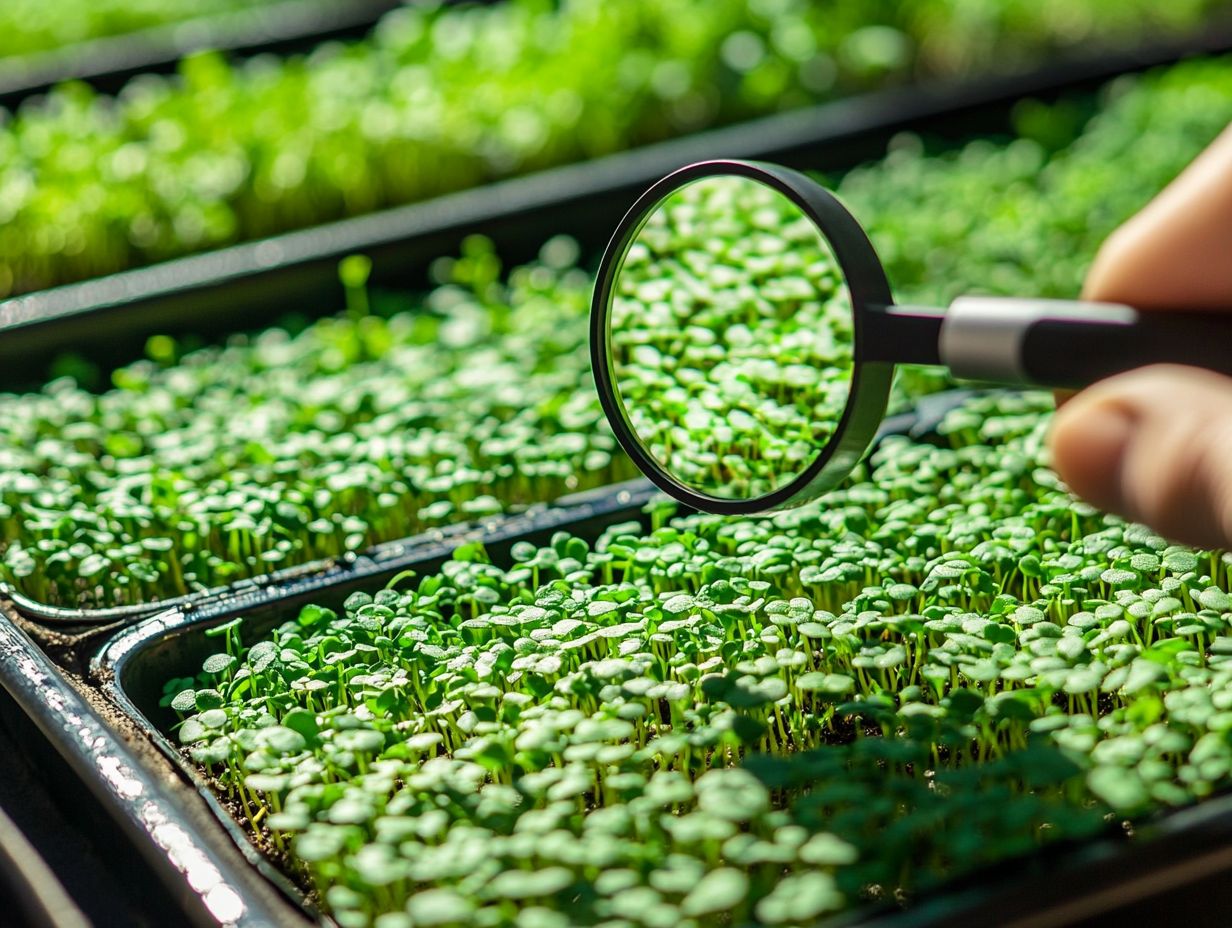
Implementing best practices for quality control in microgreens production is crucial for achieving impressive crop yields and ensuring top-notch product quality that aligns with market demand and consumer preferences.
By using optimal growing mediums, adhering to sustainable practices, and incorporating energy-efficient systems alongside composting techniques, you can significantly enhance both the quality and sustainability of your microgreens.
This approach elevates your product and minimizes your environmental footprint.
Growing and Harvesting Techniques
Effective growing and harvesting techniques are essential for you to maximize the quality and yield of microgreens. They flourish under specific conditions that provide ample light, nutrients, and pest management. Techniques like hydroponics, soil-based systems, and controlled environments empower your nutrient-rich crops to reach their full flavor potential while minimizing risks associated with pest infestations and nutrient deficiencies.
By adopting various cultivation systems such as vertical farming or aquaponics, you can optimize both space and resources, significantly boosting productivity. Integrating pest management strategies not only safeguards your delicate plants but also preserves their nutritional integrity.
Regularly monitoring and adjusting environmental factors, like light intensity and humidity, is crucial in fostering robust growth cycles. Adhering to best practices, such as crop rotation and meticulous harvesting methods, further ensures that your microgreens remain healthy and brimming with essential nutrients.
Start cultivating microgreens today and boost your meals with flavor and nutrition!
Storage and Packaging Guidelines
Proper storage and packaging of microgreens are crucial for maintaining food safety and product quality. This ensures that they remain rich in vitamins and minerals during transportation. By ensuring these delicate greens retain their nutritional value, you can enhance their appeal to discerning consumers.
Using moisture-controlled environments and eco-friendly packaging solutions helps extend shelf life. It also boosts customer satisfaction by delivering fresh, high-quality microgreens to the market, as the impact of water quality on microgreens plays a crucial role in their overall freshness and quality.
To achieve optimal conditions for these fragile plants, carefully regulate temperature and minimize light exposure. Excess light can diminish their vibrant colors and flavors, underscoring the importance of light quality for microgreens. By opting for airtight containers and insulating materials, you can effectively protect your microgreens from external contaminants and humidity fluctuations.
Incorporating techniques like vacuum sealing can enhance freshness, ensuring that your greens arrive at retail locations in prime condition. These best practices are not just about maintaining quality; they significantly influence your market success, as consumers increasingly choose products that demonstrate a commitment to health and sustainability. For more insights, consider understanding microgreen post-harvest care.
Common Quality Issues with Microgreens
Identifying and addressing common quality issues is essential for maintaining high standards throughout production. Challenges like pest infestations and nutrient deficiencies can greatly affect crop health and market viability. This underscores the importance of effective pest management and disease prevention.
Act now to monitor growing conditions and implement effective pest management strategies. Ensure a balanced nutrient profile to mitigate potential setbacks.
Identifying and Addressing Quality Concerns
<pAddressing quality concerns in your microgreens demands a systematic approach. Focus on key factors such as pest management, nutrient composition, and disease management. By conducting regular quality checks and staying alert for signs of nutrient deficiency or pest infestations, you can take timely action to protect crop integrity.
This proactive strategy involves implementing weekly inspections and meticulously documenting growth conditions. This allows you to spot deviations from standard growth patterns. By utilizing integrated pest management techniques, you further enhance your microgreens’ resilience, minimizing the need for chemical pesticides and encouraging beneficial insects to thrive. Additionally, if you encounter any challenges, refer to our guide on troubleshooting common microgreen growth issues for effective solutions.
Regular soil and water testing is crucial for ensuring optimal nutrient delivery. This plays a vital role in cultivating vibrant and healthy microgreens. For example, understanding the perfect light conditions for microgreens can significantly enhance growth. Adhering to these best practices can greatly improve your yields and bolster your market reputation, ensuring consumers receive fresh, nutritious products they can trust!
Tips for Maintaining High Quality Microgreens

To ensure the highest quality microgreens, adhere to stringent sanitation guidelines and perform regular quality checks. This helps safeguard the health and safety of your crops.
By implementing rigorous hygiene protocols and fostering a culture of quality assurance throughout production processes, you can elevate customer satisfaction and strengthen your market reputation.
Proper Sanitation and Hygiene Practices
Implementing proper sanitation and hygiene practices is crucial in the production of microgreens, as it directly influences food safety and helps prevent pest infestations. By ensuring clean growing environments and equipment, you can significantly reduce contamination risks while enhancing the overall quality and safety of your microgreens.
To achieve this, establish a routine cleaning schedule that guarantees all surfaces, tools, and containers are sanitized before and after use. Utilizing organic disinfectants can further elevate the safety of your environment.
Monitoring water quality is paramount. Contaminated water can lead to disease outbreaks in your microgreens. Regular training for your staff on best hygiene practices, including handwashing and the use of protective gear, will also help maintain high standards.
By adopting these actionable steps, you ll be amazed at how a few simple practices can transform your microgreens operation into one that prioritizes both safety and quality.
Regular Quality Checks and Record-Keeping
Conducting regular quality checks and maintaining careful records are essential practices for you as a microgreens producer. These steps not only streamline your production process but also ensure you re in full compliance with food safety standards.
This consistent approach allows you to swiftly identify potential quality issues and enhance customer satisfaction by consistently delivering high-quality products.
Implementing these methods fosters a transparent production environment. You can trace each batch from seed to harvest with ease. This level of transparency builds trust between you and your consumers, ensuring they feel confident in the safety and quality of your microgreens.
Systematically documenting growth conditions, pest management strategies, and harvest timelines helps you readily identify areas for improvement.
Ultimately, this unwavering commitment to excellence allows you not only to meet but often to exceed industry standards. This paves the way for a loyal customer base that truly values quality and reliability.
Frequently Asked Questions
What are the best practices for microgreen quality control?
The best practices for microgreen quality control include regular visual inspections, testing for contaminants, ensuring proper growing conditions, and maintaining a clean environment.
How often should microgreens be visually inspected for quality control?
Microgreens should be visually inspected at least once a day during the growing process to catch any potential issues early on.
What are some common contaminants to test for in microgreens?
Common contaminants to test for in microgreens include bacteria, mold, and heavy metals.
What factors can affect the quality of microgreens?
Temperature, humidity, light, and air circulation all impact microgreen quality.
What sanitation practices should be implemented for microgreen quality control?
Sanitation practices include regularly cleaning and disinfecting equipment, using clean water sources, and preventing cross-contamination between different batches of microgreens.
How can I ensure the best possible quality for my microgreens?
To ensure the best possible quality for microgreens, follow all recommended growing techniques, regularly inspect and test for contaminants, and maintain a clean and controlled environment.
Start implementing these steps today to ensure the best quality for your microgreens!

